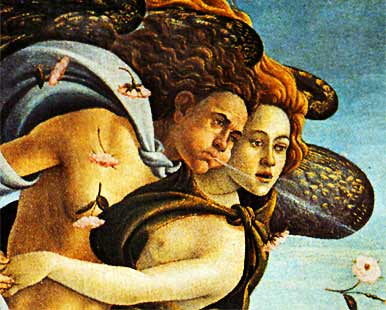
Alessandro Botticelli
The Birth of Venus

"The culmination of medievalism, the inception of modernism, center in Botticelli."
≈ from 'Religious Paintings
in History', by R. A. Cram
Alessandro Botticelli (1445-1510) was born to an upper class family in Florence. Never a student and unable to concentrate for long, he was apprenticed at 13 to his brother, Antonio, who taught him the trade of gold-beating. Tiring of this as well, he was fortunate to be introduced by a neighbor to renowned painted, Filippo Lippi, who took Sandro into his workshop.
After only a few years, still unknown yet convinced he was ready
detail 1: Botticelli's elongated,
sloping line in Venus's neck and
shoulder to seek his own commissions, Botticelli landed a court appointment to paint one of seven magistrates' chairs. His painting, "Fortitude," wowed the judges and launched his reputation among wealthy Florentine families, who flocked to the 25-year-old's new workshop with many commissions for a Madonna or saint.
Invited into Medici's circle of philosophers, poets and scholars, Botticelli worked constantly for high society families who increasingly chose classical themes for the luxurious decoration of their villas. At the peak of his career, Botticelli was the most popular painter in Florence.
No contemporary painter could rival Botticelli for the particular gracefulness, rhythm and poetic feeling of his work. Though a religious man, he was deeply influenced by the Medicis' interest in Neoplatonism, a belief that human perfection and happiness are attainable in this world. His passive, dreamy style involved a distortion of the naturalworld in the service of this poetic expression.
In Botticelli's work, reality becomes a dream or myth. Not concerned with realistic portrayals of the world, he was particularly out of place among fellow Renassiance artists obsessed with form, anatomy and perspective. Rather, he painted for nobles and upper-class patrons who desired decorative, classical themes. Botticelli's work avoided scientific naturalism in favor of elements that belonged to an earlier style - especially delicate sentiment, feminine grace, and an emphasis on the ornamental and evocative capabilities of line.
Birth of Venus (ca. 1483), painted in tempera on canvas (typical for large-scale non-religious and pagan subjects) for a Medici bedroom, illustrates characteristics of this Neoplatonic philosophy.
detail 2: Botticelli was known for his sinuous
line and lyrical, contoured forms
The picture tells the pagan myth of Venus, born from the foam of the waves and transported to the island of Cythera on a shell where, surrounded by roses, she is blown ashore by the west winds, Zephyr and Chloris. She is welcomed with a cloak by a Greek nymph of the Spring, who wears a gown decorated with daisies and other spring flowers representing birth.
As visual poetry, this work is quintessential Botticelli in its denial of rational spatial construction, its liberties taken with nature, the minimal attempt to model solid-looking figures and his characteristic elongated proportions. Here, figures float on the forward plane of the picture against a decorative landscape backdrop -- while form, defined by a graceful outline, is altered to imbue it with a tender and expressive power.
For instance, the nude, yet modest Venus is depicted in classical Greek pose, examples of which were closely studied by Botticelli and his circle. But the artist took liberties with the classical form: adding the elongated neck, radically-sloping left shoulder, oddly-hinged arm, and long, flowing hair. With his curving line depicting a complex and beautiful series of twists and turns as Venus is about to step onto shore, Botticelli highlights an otherworldly anatomy, creating his own instantly recognizable form of feminine beauty.
Also adding to the otherworldliness, Venus lands on a rugged shore populated by tall, crowded orange trees where each blossom, leaf and trunk are illuminated with gold leaf.
detail 3: classical myth interpreted with the
artist's characteristic style and tenderness
Her skin is pearly, nearly transluscent, and the cape with which she is to be covered billows extravagently in the sunlight and wind. Gold is used throughout the painting, accentuating the preciousness and echoing the divine status of Venus, much as Medievalists depicted the Madonna.
As in many of his works, classical learning appears in a contemporary, vernacular guise. While Botticelli created art of the highest refinement, classically learned and aristocratic, he also created a personal art whose beauty made it popular and accessible to all.
Having worked on the Sistine Chapel as well as for the Medicis, Botticelli's patrons included the finest churches and most distinguished families, yet, after Leonardo's return to Florence in 1500, Botticelli's unrealistic style fell out of fashion.
He also soon fell under the influence of Savonarola, whose call to repentance seemed to guide Botticelli's talents toward new, more solemn themes. Burning many of his own paintings in the notorious "Bonfire of the Vanities" and never knowing how to take care of money, he died at last in obscurity.
